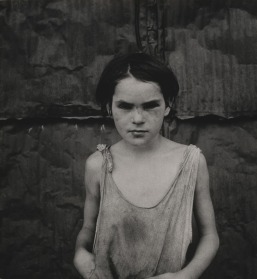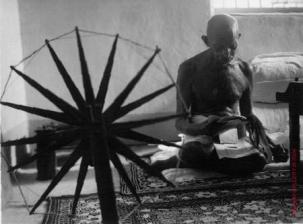PREPARATIONS for ASSIGNMENT FOUR
A Picture is worth a thousand words
Choice of image
I reflected on which image I might choose for the assignment throughout the time I was completing the exercises and research.
The image that I initially thought that I would use was The damaged child (Dorothea Lange 1936).
I saw this at the Radical Eye exhibition that I’ve reviewed recently on my blog. The image itself haunts me; the obvious hardship and poverty etched on this child is clear, but what struck me was her steely stare and the inner strength and determination that I thought Lange had also captured. My personal link to this was the reminder it gave me of under privileged children that I encountered when teaching, who though possibly hungry and with difficult home lives seemed often to possess this inner strength for their own self-preservation. I was also interested in the back story as I know from an interview with Sir Elton John that Lange had written on the back of this print an alternative title “The damage is already done”.

(The Museum of Modern Art. 2017)
I also considered this image of Welsh Miners (Robert Frank 1953) taken in Caerau South Wales where he made a photographic story about a mining community, focusing on a miner and his family. I considered the fact that it was part of a series of 16 images and that when he travelled he sought to capture portraits of people that embodied a place as these miners do. I also thought that there was a strong narrative within this photograph alone, with the bright whites of the miners eyes contrasting with their blackened faces and their smiles disguising what must have been their weariness. I also felt some affinity with the subject having visited old mines in South Wales and spoken to men that have worked in them.

(Anatomy Films, 2017)
I also seriously considered this image “Shop in Rupert Street Soho” (1953) by Cas Oorthuys which first struck me when I saw it at the exhibition Strange and familiar at the Barbican Gallery London in 2016. I remember finding the context interesting, as I spent a lot of time photographing street markets in different contexts/locations and I was attracted by the vantage point he used, which I have tried since myself. I also thought that this would be interesting to research as generally Oorthuy’s approach was as a commercial photographer, pragmatic and objective and yet there is a narrative in her London photographs.

(Strange and Familiar: Britain as Revealed by International Photographers, 2017)
The last image that I considered was London 1958-9 by Sergio Larrain. It is the perspective, the blurred slight movement of the man in the foreground that appeals me to this image. Having travelled on the underground frequently as a commuter I could smell the people, remember the old wooden escalators and appreciate the depth of this image. Many of his images in this series he captures from dynamic angles with abrupt framing and often ground level viewpoints and blurred subjects; I wondered was this because of the subject matter, or if was this present in most of his work, especially when he gave professional photography up at a relatively young age (ten years after this photo), to have more peace and time. Could he have found a calmer way to photograph?

(Pinterest, 2017)
Finally and thankfully I stumbled again upon a photograph that I do really feel passionate about, Margaret Bourke White’s “Ghandi and his spinning wheel” (Margaret Bourke-White 1946).
My passion for this photograph comes from an affinity that I have with India, having travelled around the country many many times; but more specifically that I have visited the exact location that she took this portrait in twice, most recently March this year. I remember reading in the museum text at this past residence of Ghandi’s how Margaret Bourke- White had executed the photograph, and thought it would be interesting to see if the documentation available outside supports this information. It is a very poignant photograph as Ghandi was assassinated only two year later yards from this room, having been with the same photographer talking that very day. I have a good understanding of the subject of the photograph from my travels and previous reading and yet I know very little about the photographer. So I decided that I had a good basis to begin my reading of the photograph. Passion and interest and it would be very interesting to apply my new learning on reading photographs to this photograph.

(Gallery M, 2017)
References:
Anatomy Films. (2017). Robert Frank – A Different View. [online] Available at: http://www.anatomyfilms.com/robert-frank-different-view/ [Accessed 27 Jun. 2017].
Gallery M. (2017). Margaret Bourke-White | Biography. [online] Available at: https://www.gallerym.com/pages/margaret-bourke-white-biography [Accessed 28 Jun. 2017].
Pinterest. (2017). 1950s. [online] Available at: https://uk.pinterest.com/pin/AU1bXADwnIQG6nl_8HIdeA9ts7ybGL_4cxDTIzk5t4hIOXcV9C5Cz1Y/ [Accessed 27 Jun. 2017].
Strange and Familiar: Britain as Revealed by International Photographers. (2017). Strange and Familiar: Britain as Revealed by International Photographers | Cas Oorthuys. [online] Available at: http://www.barbican.org.uk/strangeaudio/photographs/cas-oorthuys/ [Accessed 27 Jun. 2017].
The Museum of Modern Art. (2017). Dorothea Lange. Damaged Child, Shacktown, Elm Grove, Oklahoma. 1936 | MoMA. [online] Available at: https://www.moma.org/collection/works/56493 [Accessed 24 Jun. 2017].
Please note: Any images by other photographers used on this site are accredited and are being used for personal research and educational purposes only.
